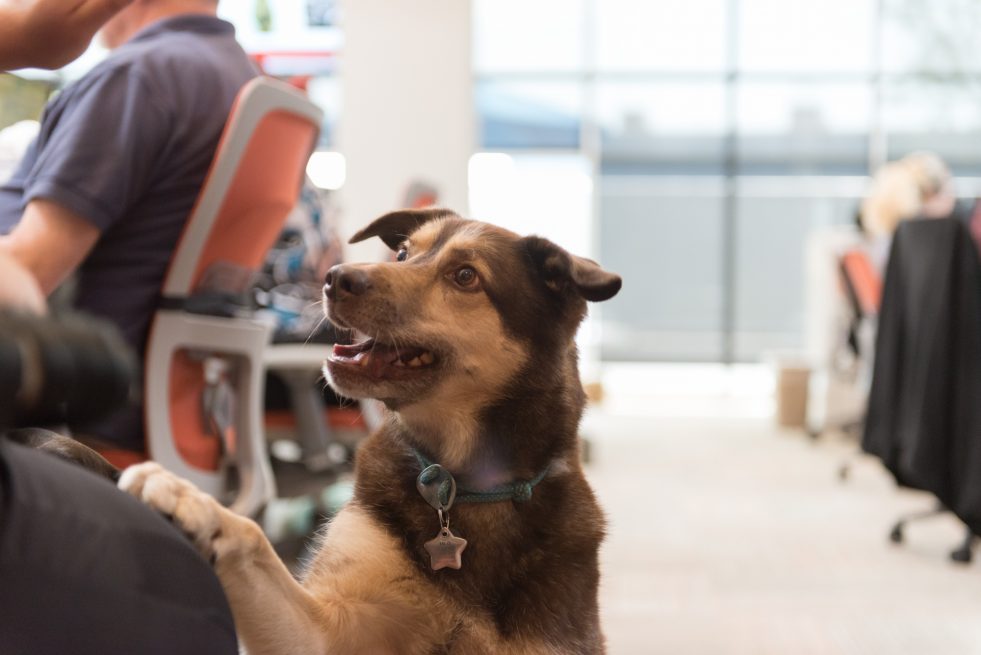Paws to the Grindstone
Chris Junior //January 22, 2020//
Workplaces can be delicate environments, each one with its own distinct set of written policies and unspoken rules regarding acceptable decorum. Some matters are no-doubt-about-it serious (the fine line between appropriate and inappropriate language), while other issues lean more toward the silly (that mystery colleague who puts fragrant lunch remains in the garbage can near the copier).
When pets are involved, a workplace’s environment and culture take on an entirely different vibe. Like most everything else on the job, there are guidelines in place and common-sense approaches pertaining to the approved presence of animals. And for a lot of businesses, allowing pets in the workplace has had a positive domino effect, proving to be beneficial in terms of employee behaviors, actions and more.
In its second “Pet-Friendly Workplace PAWrometer” survey, conducted in early 2017, Banfield Pet Hospital found that 39 percent of the 1,200 people surveyed (U.S. employees and human resources decision-makers) preferred having pets in the workplace over other pet-related benefits. The HR personnel noted that pet-friendly workplace policies contributed to improvements of 91 percent or better in the areas of employee morale, reduced stress among employees, work-life balance, greater loyalty to the company and reduced guilt among pet owners about leaving their pets at home.
Taking into account how millennials responded in the 2017 Banfield Pet Hospital survey, it doesn’t appear as though this trend is going to fade anytime soon. According to the survey, adults age 18 to 35 were “significantly more likely to find value in the positive impact pets at work have on employees (73 percent) and the workplace (70 percent).” Pet-friendly policies, it added, “are also more likely to influence a millennial’s job search, with 42 percent considering such programs important, compared to only 23 percent of older adults.”
As pet industry professionals have embraced the trend, they are mindful of the impact it has on life at work as well as life in general for pet owners and their animals.
“The more pet-friendly we make our society—which includes housing, public attractions and, of course, workplaces—the more we all benefit,” said Jacinthe Moreau, president of the World Pet Association. “One key barrier to pet ownership, especially among millennials, is working long hours and leaving pets home alone during that time. If people have the option to bring their pets with them to work every day, the more inclined they’ll be to actually take the pet step. Pet-friendly societies also help increase the human-animal bond, and strengthening that connection between owners and their pets is always in the industry’s best interest.”
Industry Efforts
Steve King, CEO at American Pet Products Association, shares a similar view about pets’ place in society, adding that his organization’s biggest contribution to date in promoting pets in the workplace is supporting research demonstrating the value of the trend.
As an example, King cites APPA’s funding of a recent study by the Human Animal Bond Research Institute. On its website, HABRI shares the results of the study (done in partnership with Nationwide) and other related material, such as the downloadable handbook “Pets in the Workplace: A Practical Guide to Ultimate Productivity and Happiness, M-F” and a short video starring workers and their dogs dubbed “The Woofice,” shot in the same style as the TV series “The Office.”
 APPA has also promoted the pets-in-the-workplace trend by actually allowing animals in their offices. More than 15 years ago, a staff member asked for permission to bring Bernie, a Wheaten Terrier, into the APPA office space in Greenwich, Connecticut. Following senior management’s approval, Bernie “quickly became a fixture at the office, visiting other staff members and sleeping under the desk that suited him best that day,” King recalled. “It was clear from the start that staff had a positive response to his presence, which inspired future pet attendance.” APPA has since moved to Stamford, and King says an important part of the negotiations with the management of its current office building was to ensure that the lease allowed for pets on the premises.
APPA has also promoted the pets-in-the-workplace trend by actually allowing animals in their offices. More than 15 years ago, a staff member asked for permission to bring Bernie, a Wheaten Terrier, into the APPA office space in Greenwich, Connecticut. Following senior management’s approval, Bernie “quickly became a fixture at the office, visiting other staff members and sleeping under the desk that suited him best that day,” King recalled. “It was clear from the start that staff had a positive response to his presence, which inspired future pet attendance.” APPA has since moved to Stamford, and King says an important part of the negotiations with the management of its current office building was to ensure that the lease allowed for pets on the premises.
The Pet Leadership Council, which has been primarily housed in the APPA offices since its inception more than five years ago, has been working with coalition members to connect with other companies working on similar initiatives, says Bob Vetere, the PLC’s executive director.
“Mars, with its pet-friendly cities initiative, has been a partner as we are reaching out to cities and associations,” he said. “We have been using a presence at Global Pet Expo and SuperZoo to help show the rest of the industry what we are doing and explaining why it is a positive avenue for the industry to pursue. We are also using the resources of HABRI to provide research validating the positive impact of having a pet-friendly workplace.”
Company Recruiting Tool
Bryan Nieman, brand director at Wisconsin-based Fromm Family Foods, says pets in the workplace have been part of his fifth-generation family-owned company’s culture from the beginning, resulting in improved employee morale along with “a welcome break at times and plenty of comic relief.”
“Each visiting dog is the hero for the day, and it’s wonderful to see how personalities play out in the office,” he said.
Even though the presence of animals is ingrained as part of Fromm’s day-to-day office life, Nieman admits that the company doesn’t always remember to encourage the trend.
“Our four-legged guests are expected to be courteous and well-behaved, and their owners make sure this happens,” Nieman added. “We find that those staff members who bring their pets to the office have animals that do well in social situations with many people coming and going. It’s the owner’s responsibility to manage meal times and potty breaks, and the entire office provides the requisite love, attention and plenty of pets throughout the day.
 Radio Systems Corporation, the parent company of the PetSafe brand, has also permitted pets in the office since day one, says Becka Wilson, a human resources business partner for the firm.
Radio Systems Corporation, the parent company of the PetSafe brand, has also permitted pets in the office since day one, says Becka Wilson, a human resources business partner for the firm.
“We certainly do promote being a pet-friendly office,” she said. “It is part of who we are, so we typically attract the type of person who will be excited about this perk—we actually ask about their own dogs on the first phone [pre-screening interview].”
RSC/PetSafe advertises its dog-friendly work environment on its website and social media accounts, as well as throughout the recruitment process.
“When candidates come in for an interview, it is likely that a dog will be in the room as well,” said Wilson. “Each of our conference rooms is named after and dedicated to an office dog, so candidates get to see that when they interview.”
In an effort to keep its facilities clean, RSC/PetSafe has waste stations outdoors and cleanup kits on each floor indoors. Dogs are required to be up to date on vaccinations and exhibit good behavior.
“Our pets are mostly free to roam, but whether they do depends on the personality of the pet,” said Wilson. “We have some dogs who make the rounds from desk to desk to say hi, and others who quietly stick around their pet parent’s work station. We’ve also learned as we go—for example, asking the owner if it’s OK to give their dog a treat in case there is a food allergy or their dog is on a special diet for health reasons.”
Meet Max the Hamster
Canines seem to be the preferred animal of choice to bring to the workplace, but not all pet-friendly offices have gone to the dogs.
At its office in Holland, Supreme Petfoods has a resident hamster named Max.
 “When you are bombarded with photos of gorgeous small pets all day, it’s hard not to yearn for one of your own,” said Claire Hamblion, marketing manager at Supreme Petfoods. “No one can really remember who suggested a resident pet, but the idea quickly gained traction.”
“When you are bombarded with photos of gorgeous small pets all day, it’s hard not to yearn for one of your own,” said Claire Hamblion, marketing manager at Supreme Petfoods. “No one can really remember who suggested a resident pet, but the idea quickly gained traction.”
Hamblion says many hours were spent discussing which pet would be ideal for the Holland office, where the habitat could be situated and how to ensure the animal’s care outside of business hours.
“We chose a hamster because they have a robust response to travel and can be easily transported to an employee’s home [on] weekends,” she said. “They are such fun to watch, and we felt [they] would add a lot to the office environment. Hamster ownership is on the increase everywhere right now because of that ability to fit in with modern lifestyles, so it’s no surprise that’s what we chose, too.”
As the head of product sniffs and nibbles in the Netherlands (“He’s regularly consulted by the marketing and development team,” explains Hamblion), 2-year-old Max has what amounts to corner-office status for a pet: a “generously sized cage,” as Hamblion describes it, and a safe zone for play. “All the advice we give to pet owners about making their home pet-friendly has been applied to our premises,” she said.
Max’s biggest contribution to Supreme Petfoods is being himself.
“Seeing our resident hamster go about his day-to-day life, having a snooze, making a cozy nest or sniffing ’round the food bowl has a way of putting everything into perspective,” Hamblion said. “When handling a small pet, you have to slow down and show calm behaviors, making our hamster the ultimate stress-buster.
“We spend so much of our lives working that we all want to think we are making a difference,” she added. “Our little hamster reminds us we are working for healthier, happier and longer lives for pets. We might be having an impact on a very small part of the world, but it’s 100 percent positive.”
Boost for Businesses
While studies have focused on how pets in the workplace have contributed to reduced stress, better collaboration and increased productivity among employees, another benefit of the trend is expanded business opportunities across the pet industry.
“Pet owners are seeking products that reinforce [the human-pet] bond not just at home, but at work,” said Wilson. “They are also seeking training tools so their pets are well trained and behaved in an office environment.”
“Items such as gates, beds, bowls, treats, toys, leashes and waste cleanup products are all necessary,” added King. “As more employers realize the benefits of a pet-friendly workplace, the pet industry is well positioned to provide these and other products.”
King expects the pet-friendly trend to ascend in the next few years.
“We’re going to have more information and research on the benefits of pets in the workplace, with resources that help workplaces incorporate a pet-friendly policy and feel comfortable with something that might seem like a big step for them right now,” he said.



















